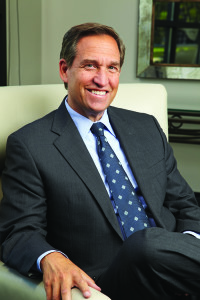BIG & TALL REPORT, PART TWO: DXL GROWS ITS MARKET SHARE


According to CEO David Levin, it’s been a good year for DXL. “We’re meeting all our financial expectations. Last year we had double-digit comp sales gains in stores open over a year. We’ll open 40 new DXL stores this year to hit 170 by year’s end and we’re projecting continued growth over the next several years.
“What’s the secret? We offer a fantastic selection of more than 50 national brands from value to luxury price points. The customers love what we’ve delivered: a true one-stop shopping experience with good, better, best fashion options and exceptional customer service. (We’ve created terrific training programs for our sellers.) Out of the 150 DXL stores we’ve opened, only one didn’t perform to our expectations.
“Another positive move we’ve made is increasing the number of smaller doors: by creating a 5,000 sq. ft. footprint that still retains the DNA of our larger (8,000 sq. ft.) stores, we’ve been able to enter more secondary markets. And the best part now is that the name recognition is out there. When we first converted Casual Male to DXL stores, we put a lot of money into national ads. So now, as we open new stores, people have seen the commercials; they recognize the name and they’re excited to shop here. (And the way these smaller stores are designed, they hold a lot of inventory!) So I believe the risk is behind us: we’re still putting in capital but it’s now more about execution than risk-taking.
“Our online business is about 18 percent to total. It’s given us much more exposure and is providing our greatest increases. And the amazing part is that our return rate online is only about eight percent vs. an industry average four times that!
“It’s now more about execution more than risk-taking.”
“I think a big reason for that is our consistency of sizing. Many of the brands we’ve introduced were not doing B&T before so they lacked the technical knowledge on sizing specifications. So we worked with them on it and gave them our specs, which means when a guy buys a 3X in our store, it’s the same size across brands so he knows what he’s getting. (We do some slimmer fits in young men’s.) This consistency is a really big advantage, especially online. I’m a regular-size guy but when I shop for jeans, I could be a 32, a 34, or a 36, depending on how much ‘vanity sizing’ is involved. So we’ve tried to eliminate the guesswork.
“We’re a big sportswear store but tailored clothing is our fastest growing category. We offer good value, we don’t play high-low price games, and I believe the customer feels comfortable in our environments. We do some made-to-measure in tailored but that’s not our emphasis.
“Bottom line, in a tough retail climate, we are bucking the trend and growing our market share. Our high comp store gains indicate that customers like what we’re doing and they’re coming back. I think JCP and Dillard’s do a good job with their dedicated B&T departments, but they’re catering more to women shopping for men, whereas Men’s Wearhouse is more of a clothing store. We’ve created an environment where guys like to shop for all their apparel needs. We’ve been able to do something that several multi-billion dollar companies were unable to do and I’m very proud of that.”








